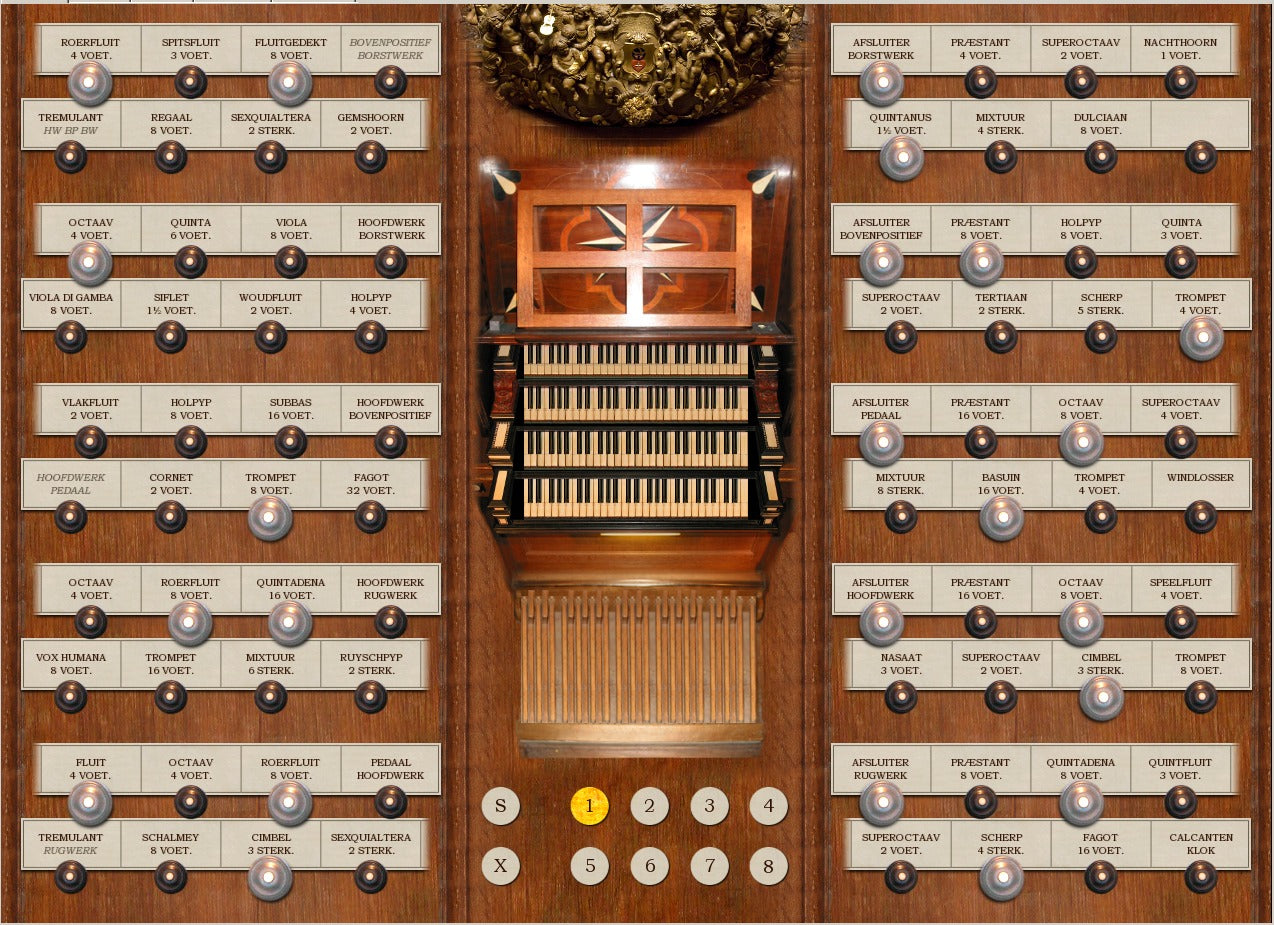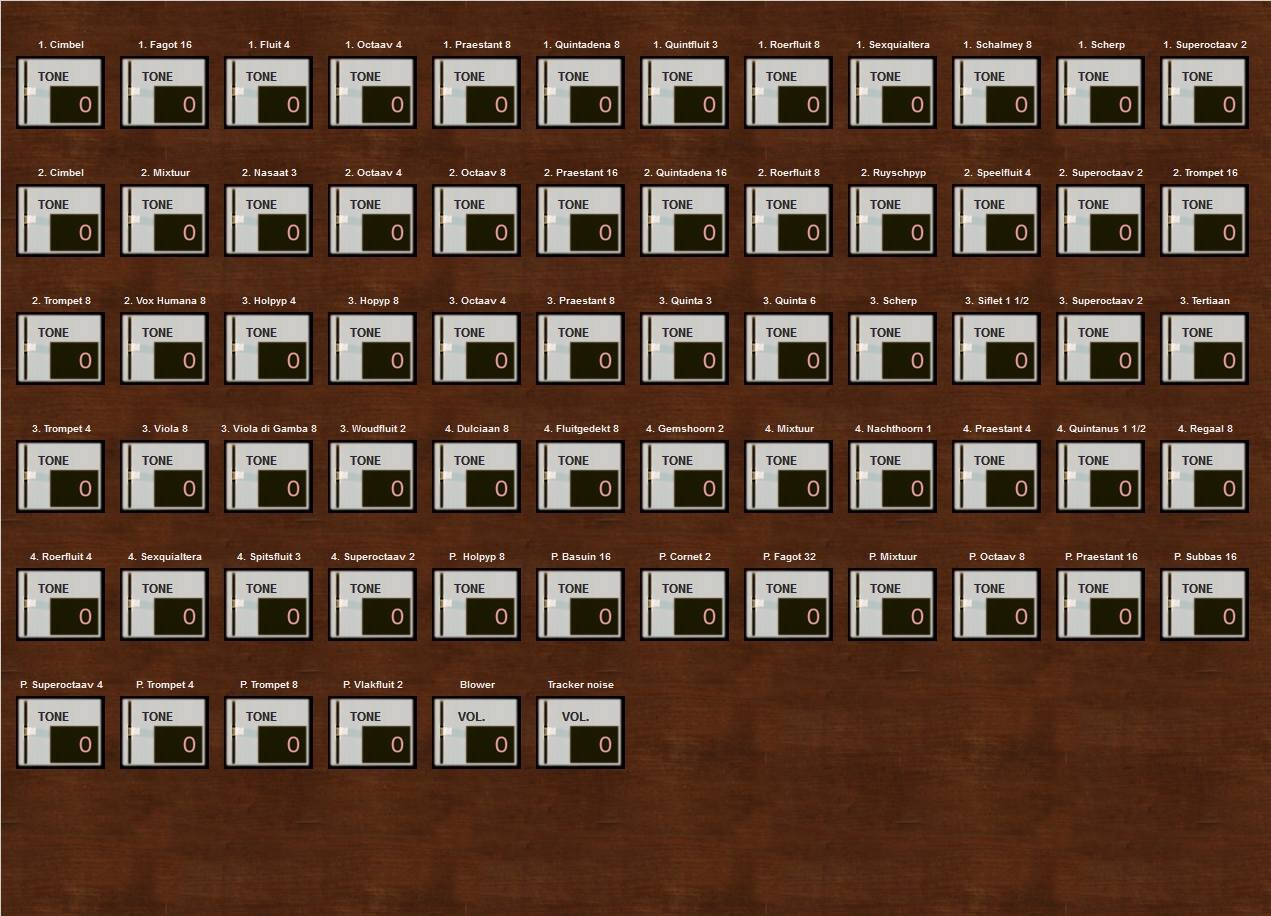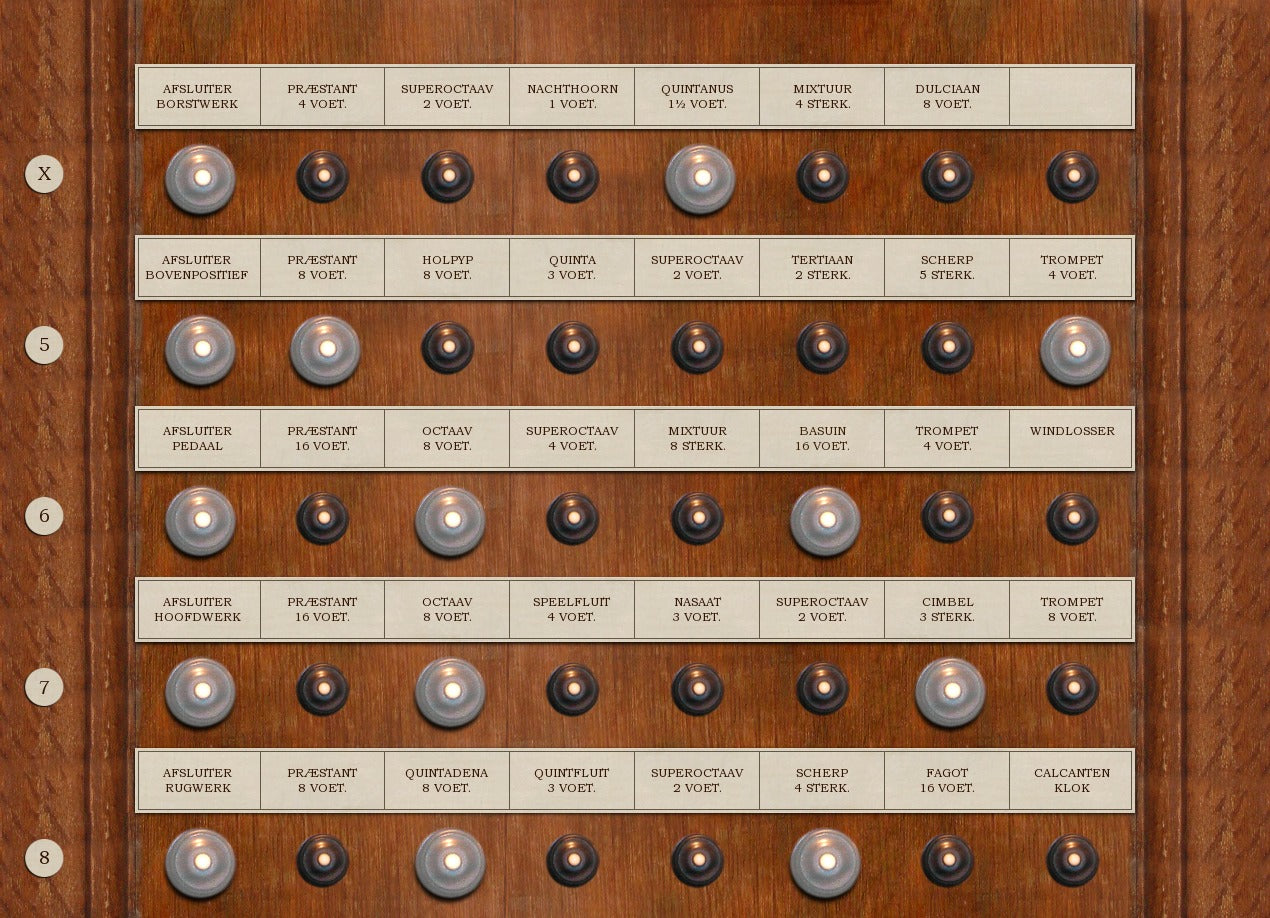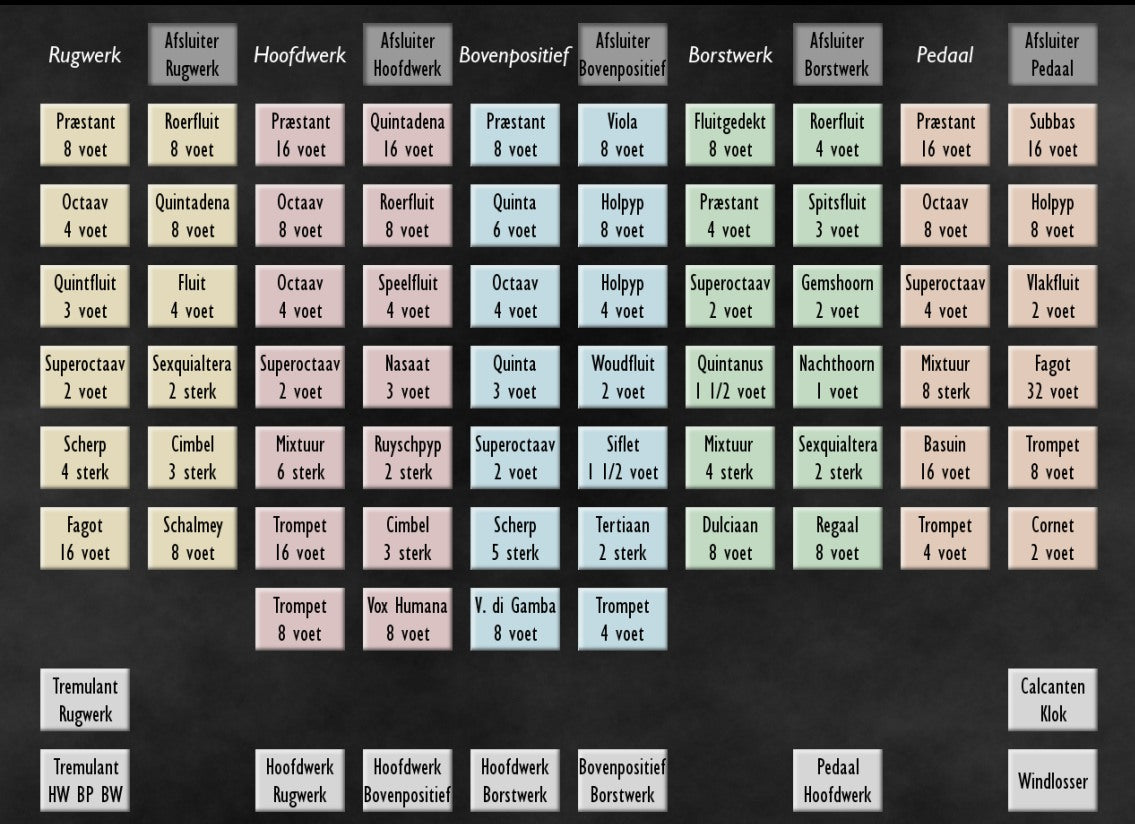Sonus Paradisi
Den Haag, Lutherse Kerk [Hauptwerk]
Den Haag, Lutherse Kerk [Hauptwerk]
Impossibile caricare la disponibilità di ritiro
Den Haag, Lutherse Kerk Bätz Organ
The history of the organ in the Evangelical Lutheran Church in The Hague begins with an organ built by Johannes Wolfgang Schonat in 1648. This instrument was expanded by Appolonius Bosch in 1668. On July 23, 1723, Rudolf Garrels began moving the organ from the north to the south side of the church. He also enlarged the instrument and modified the organ case designed by Daniël Marot. This work was finished on September 4, 1724. The organ now had two manuals and attached pedal, with a total of 14 stops. In 1751 Johann Heinrich Hartmann Bätz was commissioned to build a new organ with two manuals and attached pedal and 23 stops using parts of the existing instrument. The Garrelscase was retained. The Bätz organ was completed on September 18, 1753.
Beginning in 1988, a restoration started in phases performed by Flentrop Orgelbouw in Zaandam. In 1988, both wind chests of the pedal were repaired, along with pipes of the Bourdon 16. In 1995, those of the Rugwerk were repaired and a new Sexquialter II st. was built by Flentrop according to Bätz's scaling.
A major restoration of all remaining unrepaired parts of the organ was carried out in the period June 2006 - September 2007. This restoration included the wind chests of Hoofdwerk, Bovenwerk and Zwelwerk, the wind supply, playing and stop action, keyboards, pipes, and organ case. The basis for this restoration was the organ's composition in 1762/1837, with preservation of the Zwelwerk from 1921. During the restoration, the three stops (Octaaf 4', Nasard 3' and Scherp) placed on the Bovenwerk in 1948 were removed. A Nasard 2 2/3' was made according to Bätz's scaling. The Octaaf 4' was placed on the Zwelwerk. Also, the Zwelwerk was expanded with a Basson-Hobo 8' that was constructed around the time the Zwelwerk was first built. The pneumatic action of the Zwelwerk was replaced by an electric action. The main tremulant was changed from a pneumatic variety to a classic tremulant, and the windpressure of the entire instrument was reduced to 87mm to be more similar to other Bätz organs.
Presentato a te da Leonart Studio, il tuo rivenditore autorizzato per Sonus Paradisi in Svizzera (spedito a livello internazionale). Ottieni i tuoi organi storici campionati digitalmente per l'uso con il software per strumenti virtuali Hauptwerk.
Condividi questo Set di Campioni
![Den Haag, Lutherse Kerk [Hauptwerk]](http://artful.shop/cdn/shop/files/batz1.jpg?v=1759141793&width=1445)
![Den Haag, Lutherse Kerk [Hauptwerk]](http://artful.shop/cdn/shop/files/batz2.jpg?v=1759141794&width=1445)
![Den Haag, Lutherse Kerk [Hauptwerk]](http://artful.shop/cdn/shop/files/batz3.jpg?v=1759141794&width=1445)
![Den Haag, Lutherse Kerk [Hauptwerk]](http://artful.shop/cdn/shop/files/batz4.jpg?v=1759141793&width=1445)
![Den Haag, Lutherse Kerk [Hauptwerk]](http://artful.shop/cdn/shop/files/batz5.jpg?v=1759141794&width=1445)
![Den Haag, Lutherse Kerk [Hauptwerk]](http://artful.shop/cdn/shop/files/batz6.jpg?v=1759141794&width=1445)
![Den Haag, Lutherse Kerk [Hauptwerk]](http://artful.shop/cdn/shop/files/batz7.jpg?v=1759141793&width=1445)
![Den Haag, Lutherse Kerk [Hauptwerk]](http://artful.shop/cdn/shop/files/batz8.jpg?v=1759141792&width=1445)
![Den Haag, Lutherse Kerk [Hauptwerk]](http://artful.shop/cdn/shop/files/batz9.jpg?v=1759141791&width=1445)
![Den Haag, Lutherse Kerk [Hauptwerk]](http://artful.shop/cdn/shop/files/batz10.jpg?v=1759141792&width=1445)
![Den Haag, Lutherse Kerk [Hauptwerk]](http://artful.shop/cdn/shop/files/batz11.jpg?v=1759141792&width=1445)
Specifiche (elenco di stop)
-
Manuale I
I Rugwerk 49 (54) keys
Prestant 8'
Holpyp 8'
Octaaf 4'
Fluit 4'
Octaaf 2'
Flageolet 1'
Sesquialter II
Mixtuur III-IV
Dulciaan 8'
Tremulant
-
Manuale II
II Hoofdwerk 49 (54) keys
Bourdon 16'
Prestant 8'
Roorfluit 8'
Quintadeen 8'
Octaaf 4'
Nagthoorn 4'
Quint 3'
Octaaf 2'
Woudfluit 2'
Cornet IV
Mixtuur VI
Fagot 16'
Trompet 8'
Trompet 4'
Tremulant -
Manuale III
III Bovenwerk 49 (54) keys
Prestant 8'
Baarpyp 8'
Quintadeen 8'
Roorfluit 4'
Nasart 3'
Fluit 2'
Schalmy 8'
Vox Humana 8'
Tremulant
-
Manuale IV
IV Zwelwerk 61 keys
Holpyp 8'
Dolce 8'
Viola di Gamba 8'
Voix Celeste 8'
Octaaf 4'
Flûte Harmonique 4'
Woudfluit 2'
Hobo 8'
Tremulant
-
Pedale
Pedaal 25 (30) keys
Prestant 16'
Bourdon 16'
Subbas (zw) 16'
Prestant 8'
Bourdon (zw) 8'
Violoncel (zw) 8'
Roorquint 6'
Octaaf 4'
Bazuin 16'
Trompet 8'
Trombone 4' -
Altre specifiche
Couplers: RW/HW , BW/HW, HW/P, ZW/P
Transpositeur Bovenklavier (shifts Zwelwerk stops one octave higher)
Ventil (Afsluiting) for each manual and pedal, Ventiel (to empty the bellows, no function in Hauptwerk)
Storia
The history of the organ in the Evangelical Lutheran Church in The Hague begins with an organ built by Johannes Wolfgang Schonat in 1648. This instrument was expanded by Appolonius Bosch in 1668. On July 23, 1723, Rudolf Garrels began moving the organ from the north to the south side of the church. He also enlarged the instrument and modified the organ case designed by Daniël Marot. This work was finished on September 4, 1724. The organ now had two manuals and attached pedal, with a total of 14 stops. In 1751 Johann Heinrich Hartmann Bätz was commissioned to build a new organ with two manuals and attached pedal and 23 stops using parts of the existing instrument. The Garrels case was retained. The Bätz organ was completed on September 18, 1753.
In 1759, Bätz dismantled this organ and stored it due to the demolition of the church building and the construction of the current church. In 1760 it was decided to have a much larger organ built in the new church, with three manuals and a stand-alone pedal. For the new organ, Bätz again used Garrels' case as a starting point, and many older parts and some earlier pipework were also included. The work was completed on September 2, 1762. The pipes of the Hoofdwerk and Rugwerk mainly date from 1753, the pipes of the Pedaal and Bovenwerk from 1762. Bätz used three stops of the Rugwerk from Schonat's former organ, namely Holpijp 8', Octaaf 2,' and three ranks of the Mixtuur. The fourth rank of the Mixtuur is probably by Garrels. This pipework is still in the present Rugwerk today.
From 1762 until 1824 the instrument remained essentially unchanged. In 1824, Jonathan Bätz, grandson of Johann Heinrich Hartmann, restored and modified the organ. He added two new bellows, replaced the metal Bourdon 16' with a wooden one, made a new main manual with a new coupler and a new pedal keyboard, made a new tremulant for the Bovenwerk, and tuned the organ to equal temperament. In 1837, the organ was again restored and modified by Jonathan Bätz, with a number of changes in the disposition. The Hoofdwerk Mixtuur was expanded with pipes from the Scherp, and the Scherp was replaced by a Fagot 16'. The Dulciaan 8' was changed to a Trompet 4'. The Pedal received a Roerquint 6' in place of the Mixtuur, and the Cornet 2' was replaced by a Trompet 4'. On the Bovenwerk, a Salicionaal 4', a Roerfluit 4' and a Roerfluit 2' replaced the Horn 4', the Flageolet 1' and the Nachthoorn 2'. Finally, on the Rugwerk the Flageolet 1' was moved up to a 1 1/3' and the Sexquialter was dropped. In 1891, the front pipes were renewed by Johann Frederik Witte, who continued Bätz's business. In the process, the doubled ranks of the Prestanten were also removed.
The organ was expanded by A. Bik in 1921 with a Zwelwerk on a pneumatic cone chest behind the Hoofdwerk. This division can be played from the third manual and the pedal, and is installed in a separate case behind the organ. Bik placed a new Sexquialter on the Rugwerk in the place that became vacant in 1837. The Salicionaal 4' of the Bovenwerk from 1837 was replaced by a Nasard 3', and the Bovenwerk was enlarged by two stops with an Octaaf 4' and a Scherp, placed on a bench above the wind chest. The instrument otherwise remained unchanged. The updated organ was inaugurated on November 18, 1921. In 1970, De Koff overhauled and renewed the mechanism of the organ.
Beginning in 1988, a restoration started in phases performed by Flentrop Orgelbouw in Zaandam. In 1988, both wind chests of the pedal were repaired, along with pipes of the Bourdon 16. In 1995, those of the Rugwerk were repaired and a new Sexquialter II st. was built by Flentrop according to Bätz's scaling.
A major restoration of all remaining unrepaired parts of the organ was carried out in the period June 2006 - September 2007. This restoration included the wind chests of Hoofdwerk, Bovenwerk and Zwelwerk, the wind supply, playing and stop action, keyboards, pipes, and organ case. The basis for this restoration was the organ's composition in 1762/1837, with preservation of the Zwelwerk from 1921. During the restoration, the three stops (Octaaf 4', Nasard 3' and Scherp) placed on the Bovenwerk in 1948 were removed. A Nasard 2 2/3' was made according to Bätz's scaling. The Octaaf 4' was placed on the Zwelwerk. Also, the Zwelwerk was expanded with a Basson-Hobo 8' that was constructed around the time the Zwelwerk was first built. The pneumatic action of the Zwelwerk was replaced by an electric action. The main tremulant was changed from a pneumatic variety to a classic tremulant, and the windpressure of the entire instrument was reduced to 87mm to be more similar to other Bätz organs.
Further reading:
Dutch Organ Database, no.1000801 (orgbase.nl).
Muziek (https://luthersdenhaag.nl/).
Caratteristiche
The samples are offered in 48kHz/24bit resolution. The multiple releases have three levels: short, mid and long.
Reverb time
The reverb time is ca. 4 seconds.
Keyboards, pedalboard
The original compass of the keyboards is 49 keys (C-c4), extendable to 54 keys via a mixer switch in Hauptwerk. The original compass of the pedal division is 25 keys, extendable to 30 keys via a mixer switch. Zwelwerk stops have the original compas of 61 keys (C-c5).
Tremulants
All ranks were recorded with and without tremulants for the most convincing tremulant behavior. It is possible to select to use the artificial tremulant instead if desired (the switch is located on the mixer tab). The Hoofdwerk tremulant is partially affecting Bovenwerk and Pedaal stops (the effect is modelled in the sample set). The result is not very useful musically, but it is a feature of the organ, so it was modelled in the sample set. Alternatively, user can disable the HW tremulant operation on Bovenwerk and Pedaal via a dedicated mixer switch in Hauptwerk.
Surround format
The sample set is offered in a Surround variant (8 channels). There are direct channels, diffuse channels, distant channels and rear channels. To reproduce the surround format, an audio card with at least 4 output channels is required, dedicating the direct and diffuse channels for the front speakers, and other two channels for the rear speakers.




Requisiti
The multi-channel (surround) variant requires Hauptwerk v7 and higher supported. The sample set is encrypted, Hauptwerk iLok necessary. There is a smaller variant, stereo-only (diffuse channels solo) which is not encrypted, it requires Hauptwerk v4.2 and higher.
Requirements
RAM consumption: 8-channel surround
16-bit, other settings default: 49 GB
20-bit, other settings default: 75 GB
24-bit, other settings default: 94 GB
RAM consumption: 2-channel stereo
16-bit, other settings default: 14 GB
20-bit, other settings default: 22 GB
24-bit, other settings default: 25 GB
Screen resolution 1280x1024 px or more.
Polyphony of 8.000 voices recommended for the full suround.
Questo set di campioni Hauptwerk è presentato a te da Leonart Studio, un rivenditore autorizzato per il produttore Sonus Paradisi in Svizzera (spedizione internazionale). Goditi questa libreria di organi campionati digitalmente per l'uso con il software Hauptwerk e inizia ad ampliare la tua collezione di organi storici oggi stesso.
0
Articoli totali
CHF 0.00
Subtotale prodotto
Altri set di campioni Hauptwerk
-
Casavant, 1995 [Hauptwerk]
Produttore:Sonus ParadisiPrezzo di listino CHF 174.90Prezzo di listinoPrezzo unitario / per -
Bückeburg, 1997 [Opera principale]
Produttore:Sonus ParadisiPrezzo di listino Da CHF 1.10Prezzo di listinoPrezzo unitario / per -
Schwerin, Dom, Ladegast Organ 1871 [Hauptwerk]
Produttore:Sonus ParadisiPrezzo di listino CHF 616.00Prezzo di listinoPrezzo unitario / per -
Segovia, 1772 [Hauptwerk]
Produttore:Sonus ParadisiPrezzo di listino CHF 317.90Prezzo di listinoPrezzo unitario / per -
Reuter, 1928 [Hauptwerk]
Produttore:Sonus ParadisiPrezzo di listino CHF 473.00Prezzo di listinoPrezzo unitario / per -
![Rotterdam Hoofdorgel, 1973 [Hauptwerk]](//artful.shop/cdn/shop/files/ss_RotterdamMain1.jpg?v=1693279529&width=533) In offerta
In offertaRotterdam Hoofdorgel, 1973 [Hauptwerk]
Produttore:Sonus ParadisiPrezzo di listino Da CHF 330.00Prezzo di listinoPrezzo unitario / perCHF 958.10Prezzo scontato Da CHF 330.00In offerta -
![Groningen, 1450-1740 [Opera principale]](//artful.shop/cdn/shop/files/ss_Groningen1.jpg?v=1693275425&width=533) In offerta
In offertaGroningen, 1450-1740 [Opera principale]
Produttore:Sonus ParadisiPrezzo di listino Da CHF 658.90Prezzo di listinoPrezzo unitario / perCHF 1,681.90Prezzo scontato Da CHF 658.90In offerta -
![Frankfurt a.d. Oder, 1975 [Opera principale]](//artful.shop/cdn/shop/files/ss_frankfurtoder1.jpg?v=1692974219&width=533) In offerta
In offertaFrankfurt a.d. Oder, 1975 [Opera principale]
Produttore:Sonus ParadisiPrezzo di listino Da CHF 220.00Prezzo di listinoPrezzo unitario / perCHF 550.00Prezzo scontato Da CHF 220.00In offerta -
Piacenza, 1838 [Hauptwerk]
Produttore:Sonus ParadisiPrezzo di listino CHF 330.00Prezzo di listinoPrezzo unitario / per -
Lüdingworth, 1683 [Opera principale]
Produttore:Sonus ParadisiPrezzo di listino CHF 330.00Prezzo di listinoPrezzo unitario / per












![Casavant, 1995 [Hauptwerk]](http://artful.shop/cdn/shop/files/ss_casavant1.jpg?v=1693319885&width=533)
![Bückeburg, 1997 [Opera principale]](http://artful.shop/cdn/shop/files/ss_bueckeburg1.jpg?v=1692967628&width=533)
![Schwerin, Dom, Ladegast Organ 1871 [Hauptwerk]](http://artful.shop/cdn/shop/files/ladegast1.jpg?v=1759140126&width=533)
![Segovia, 1772 [Hauptwerk]](http://artful.shop/cdn/shop/files/ss_segovia1.jpg?v=1714213906&width=533)
![Reuter, 1928 [Hauptwerk]](http://artful.shop/cdn/shop/files/ss_Reuter1.jpg?v=1693321024&width=533)
![Rotterdam Hoofdorgel, 1973 [Hauptwerk]](http://artful.shop/cdn/shop/files/ss_RotterdamMain1.jpg?v=1693279529&width=533)
![Groningen, 1450-1740 [Opera principale]](http://artful.shop/cdn/shop/files/ss_Groningen1.jpg?v=1693275425&width=533)
![Frankfurt a.d. Oder, 1975 [Opera principale]](http://artful.shop/cdn/shop/files/ss_frankfurtoder1.jpg?v=1692974219&width=533)
![Piacenza, 1838 [Hauptwerk]](http://artful.shop/cdn/shop/files/ss_piacenza1.jpg?v=1693003521&width=533)
![Lüdingworth, 1683 [Opera principale]](http://artful.shop/cdn/shop/files/ss_luedingworth1.jpg?v=1692998051&width=533)